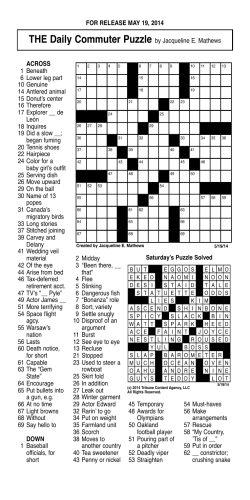
Working with Wood & Tools Working Plans
Working with Wood & Tools Working Plans You can make any of the following items, or some of your own. Change the drawings or use other materials if you like. Your project leader will have some ideas, too. There are several ways to make each article. Use the skills you have learned to experiment a little, or ask your project leader for advice on how to proceed. The most important thing is that you have fun, and do your woodworking safely! Coping Saw Puzzle Materials needed • A piece of ¼" plywood or paneling or ¼" mediumdensity hardboard about 6" x 8" • One plastic or paper bag or large envelope to hold the completed puzzle Tools needed • Square • Pencil • Saw for square cuts • Coping saw or a jigsaw for curved cuts Instructions 1.Draw a wavy line around the piece near the edge. Keep the line at least ½" and not more than 1¼" from the edge. Sandpaper Block Use Holds ¼ sheet of sandpaper. Most sandpaper is 9" x 11". Sandpaper held on a block lasts much longer than the same paper ruffled up in your hand. The block can be improved slightly by gluing a piece of felt or thin rubber on the sanding side of the block. 2.Cut along this line to cut out the center piece. 3.Draw more wavy lines on the center piece for the puzzle. 4.Cut along these lines to make your puzzle. Put each piece in the paper bag or envelope. Do not lose any of the puzzle. Instructions Apply a penetrating finish to all surfaces of the sandpaper block, unless you plan to glue on a piece of felt or thin foam rubber. Do not apply finish to areas to be covered with these materials. Materials needed • One piece of wood 2½ to 3” wide and 5½” long (this can be either ¾ or 11⁄8" thick). • Finish materials described in this publication • Felt or foam rubber if desired Tools needed • Square • Pencil • Saw • Sandpaper (80-grit for rough lumber and 120-grit for smooth lumber) 19 Working with Wood & Tools Nail Point Design Use Made from ¾" or thinner lumber, the design can be used as a hot-pad or wall plaque. Made from a piece of material 1½" thick, or thicker, it can be used as a paperweight or a decorative object for a shelf. Materials needed: • A piece of lumber about ¾" x 5½" x 5½" • Smoothing or sanding materials Tools needed • Saw • Square • Pencil • Hammer • Plane, wood-forming tool, wood rasp, or coarse sandpaper if you plan to slope or bevel the edges • 1" wire nails to form a fine line of nail point holes • Six-penny nails to form a medium line of nail point holes • Ten-penny nails to form a heavy line of nail point holes • Sandpaper (80-grit for rough wood and 120-grit for smooth wood) Instructions 1.Use your hammer and nails to make lines of nail point holes to replace your pencil lines. 2. Use the sandpaper to sand off the pencil lines. Brush the dust out of the nail point holes. Letter Holder Materials needed • One piece of 1 x 2 (actual dimension approximately ¾" x 1½") 6" long • Enough plywood or paneling to cut two pieces each 4" x 6" • Eight 1-inch wire brads • Glue • Smoothing or sanding materials described in this manual 2.Mark the cutout lines for the side pieces. Remember, most plywood and paneling has one side better than the other side. Arrange your pieces so the best side of the plywood will be the outside of both the front and back piece. You may want to nail both pieces together and cut them at the same time. Other ideas • Add designs or decals to the side pieces. • Use different material and change the shape. • Make it larger so it can serve as a napkin holder. Tools needed • Square • Pencil • A saw for square-cuts • A coping saw or jigsaw for curve cuts • Pencil compass • Hammer • Nail set • Sandpaper (80-grit for rough wood and 120-grit for smooth wood) Instructions 1. Cut the center piece to measure 6" long. 20
© Copyright 2025





















